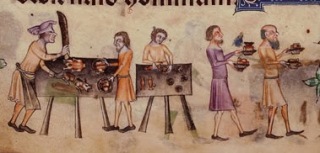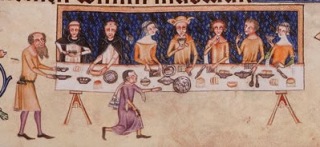This is reposted from my old blog on Blogger.
Let’s start with the basics:
- Keep in mind the scope of the SCA:
- The SCA is officially recreating pre-1600 Western Europe, with some wiggle room for “cultures that would have had contact with Western Europe.” This can help you figure out how to focus your research into cooking, and this is what I (and most SCAdians) mean when using the shorthand of describing something as “period.” So while saying something is period is kind of a bad sloppy habit we have (when we should say “Item X is historical for time period Y in place Z”), it is an easy way of delineating “SCA acceptable” from “outside our scope.” (And note that I’m not making any comment on whether or not the SCA should be more or less limiting than this.)
- Make an attempt:
- In the SCA, we require that everyone make an attempt at period clothing. Similarly, everyone can make an attempt at making and eating period food. Even if all anyone did was commit to not bringing blatantly modern foods to potlucks (pizza, brownies, etc.), we could significantly improve the quality of events. It is my aim to educate as many people as possible about historical (and passable) options that are achievable for people with various skill levels. You do not have to make a cockentrice right out the gate (but if you want to, go for it!) — everyone taking one step toward historical authenticity has a more powerful impact than a small minority of people taking a thousand steps and leaving everyone else behind. Take that step with me, I’ll hold your hand 🙂
Approach historical cooking with the right mindset:
- Period food is yummy!
- Real people really ate this food, and just as when you branch out of your comfort zone and try food from another country, trying food from another time can often result in you discovering that, in fact, the unfamiliar can often be awesome.
- Stick to your strengths.
- It’s okay to stay within your comfort zone, especially at first. Love to bake? Try some 16th century cookie recipes. Can’t read Middle English, or uncomfortable just winging it with no quantities or specific cooking directions? Look for recipe translations and modernizations (stay tuned for links and cookbook suggestions).
- Food is sacred.
- There’s a reason why cultural celebrations (ahem: including SCA feasts) and religious ceremonies center around food. Food is a big deal! You will spend a phenomenal portion of your life acquiring, preparing, and consuming food; why waste that time? Food can and should be more than just bare nourishment. Food is art, food is passion, food is science, food is love, food is joy. Within the SCA, historical food is a way to experience historical life. Take that opportunity, it’s worth it.
Where to start:
- Avoid new-world and blatantly modern foods
- Think tiny changes. If you were going to bring chocolate chip cookies to the potluck, bring shortbread instead. If you normally bring salsa and corn chips, bring hummus and pita bread.
- Pick a culture (a specific time and place) that interests you
- Then do some research. This can match your persona but doesn’t have to. Maybe you’re going to a potluck at an event with a theme, or maybe you just think Spanish food is tasty and you’d like to try some historical Spanish food. If you can personalize your quest for historical food a little, you’ll have more fun with the journey.
- Find a recipe or two that looks tasty and make it
- See my suggestions for sources below. Maybe cook something in small quantities at home to try it out before taking it to an event to get a sense of it. If your first attempt doesn’t appeal to you or doesn’t work, don’t give up; try something else.
A word on New World vs Old World foods: the conquest of the New World changed the global food landscape forever. There are a lot of foods that we take for granted that medieval people did not know about. While it’s true that some New World foods were adopted into European cuisines prior to the end of the SCA’s time period, the forms they took at first are often ones that are complete unfamiliar to us now; white potato jam is period, mashed potatoes not so much. One of the simplest ways to begin to explore period cooking is to try going without New World ingredients. Don’t despair, though: there are lots of Old World foods that are awesome in and of themselves. Here are some representative lists of New World and Old World foods; these are far from complete:
- New World: Potatoes, sweet potatoes, corn, vanilla, chocolate, tomatoes, squash (winter and summer varieties), most beans, turkeys, quinoa, pecans, cashews, peanuts, macadamia nuts, Brazil nuts, cranberries, peppers, sunflowers, avocado, agave, huckleberry, jicama, manioc, wild “rice”, yucca, green beans
- Old World: Barley, wheat, rye, carrots, parsnips, turnips, rice, lentils, garbanzo beans, fava beans, cows, sheep, pigs, goats, chickens, ducks, geese, deer, elk, many types of fish, millet, cabbage, Brussels sprouts, lettuce, most common herbs and greens, almonds, walnuts, chestnuts, eggs, dairy, apples, onions, garlic, leeks, bees (honey), cane sugar, artichoke, asparagus, beet, cantaloupe, citrus, cucumber, fig, garlic, grape, hazelnut, peaches, pears, radishes, pheasant, peacock, heron, mushrooms, gourds, and more
- Totally modern: Chemical leavening agents, industrially processed foods, and many vegetable varieties (for example rutabagas and sugar beets)
Where to find recipes online:
- Right here! Search or use the tag “recipe” and you’ll find lots
- Gode Cookery
- Medieval Cookery
- Cariadoc’s Miscellany
- and more
My favorite cookbooks for beginners.
Things you can bring even if you can’t cook:
- Desserts: candied ginger, dried fruit, shortbread cookies, dates, yogurt with honey, marzipan / almond paste, fresh whole or cut up fruit, candied nuts, baklava, candied orange peels, quince paste (sold as “membrillo”), fruit and nut “cake” (Spanish “Pan de Orejon”), butter wafer cookies (Trader Joe’s has these), tiny fruit tarts
- Nibbles: cheese, olives, nuts, hard boiled eggs, hummus and vegetables / pita bread, salami and other cured meats, pickled mushrooms, pickled vegetables (check the New World / Old World lists above), pâté
- Salad mix with oil and vinegar dressing
- Rotisserie chicken, pre-cooked ham, smoked fish, sausages and mustard, pre-cooked meatballs (especially with a simple medieval sauce like any of the ones based on vinegar, spices, and bread crumbs)
- Pasta (cheese ravioli, egg noodles, etc.) with butter and cheese
Final thought: Don’t forget that this is supposed to be fun. And historical authenticity is really fun.
Really:









Excellent and useful article. Please note that Urtatim says the hummus is not period. Not my area of expertise, but I thought you’d want to know.
LikeLike
Oh, good to know! Yeah, not my area of expertise either; I guess more research is required 🙂
LikeLike
Macadamias are not ‘New World’ they actually originate in Australia, it was just that a couple of 20th Century Anglo-Hawaiians invented a machine that could break the shells without mashing the contents on an industrial scale. They then proceeded to market ‘Hawaiian Macadamias’ – its like the Chinese and Indians insisting that they have ‘always’ had chillies and that they are ‘native’ plants.
The shells are hard enough to use as arrow points – a friend uses them to make whistling arrows with the aid of a few ants to clean the nut meat from the shell.
I’d take Baba Ganoush over Hummus any day – eggplant, garlic, olive oil, salt, optional bread crumbs, green onions/shallots. The name may be modern but the ingredients and method are not, and it appears under a wide variety of names around the Mediterranean and Middle East – just watch out for things like Imam Bayildi which usually contains tomato and chilli derived pastes.
LikeLike
Fair points 🙂
In my mind, Australia counts as “New World” — I’m using “New World” and “Old World” here as quick shorthand for “did medieval Europeans know this was a thing?” and in this case the answer is a definite no! I suppose I need a better shorthand.
Mostly, I just really don’t want anyone to bring macadamia and white chocolate chunk cookies to a feast 😉
LikeLike